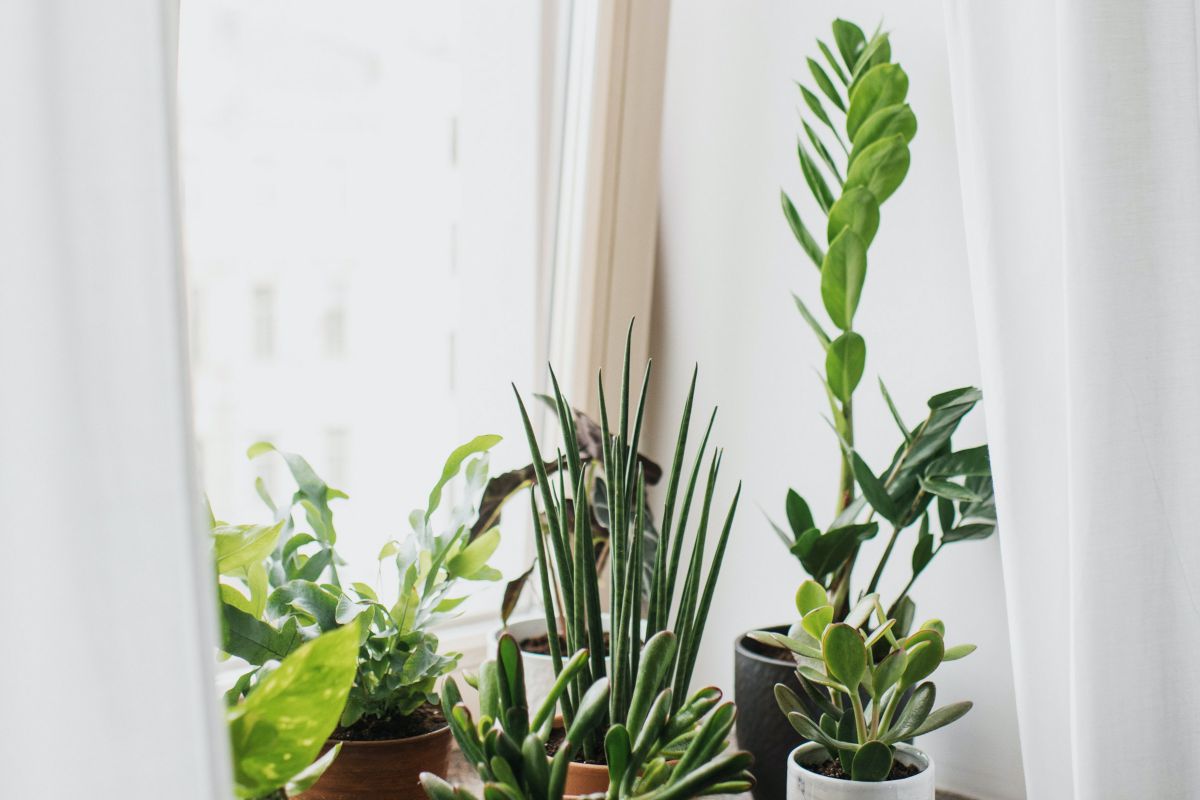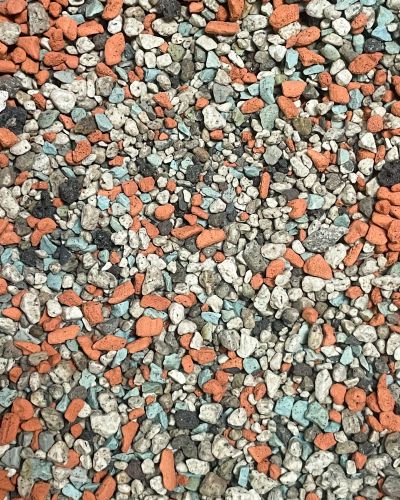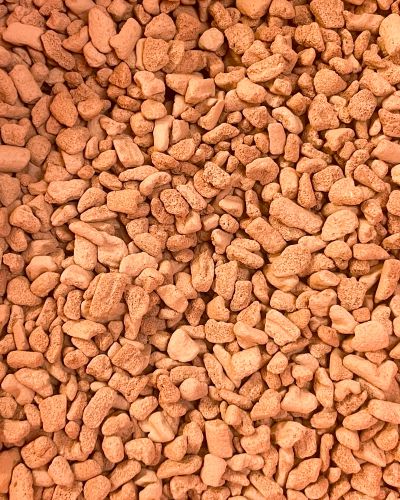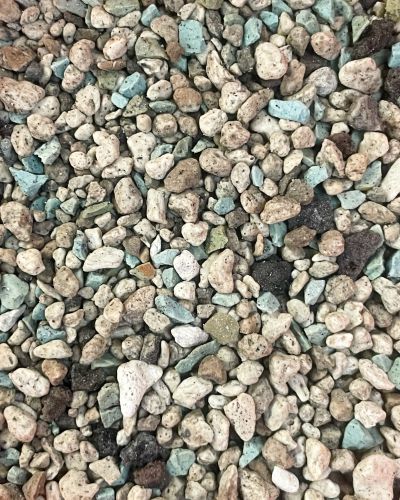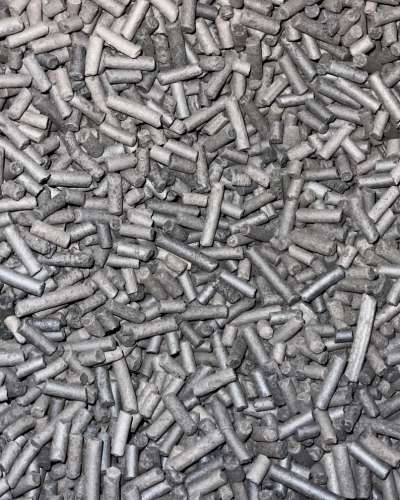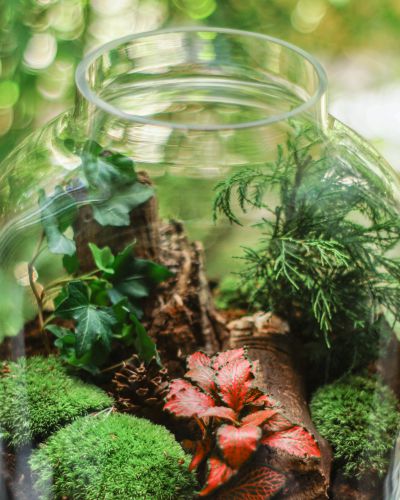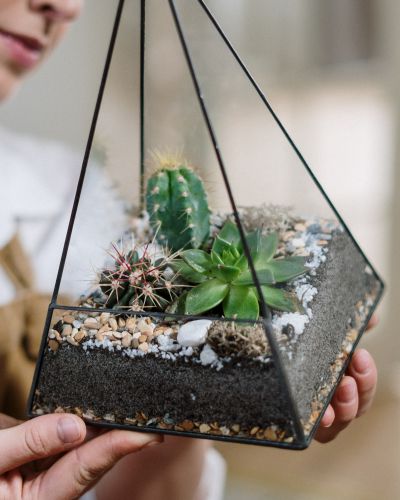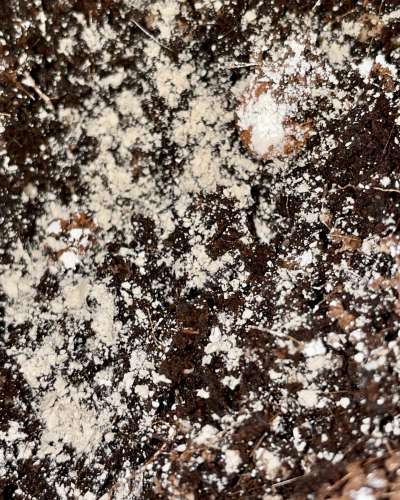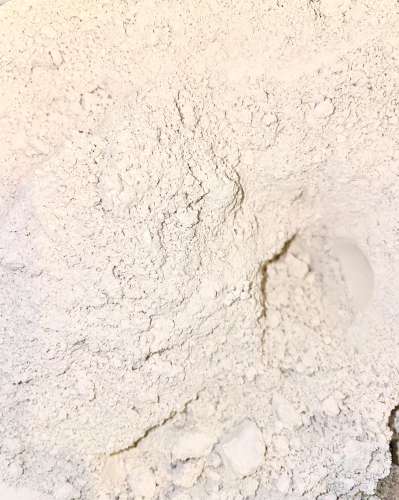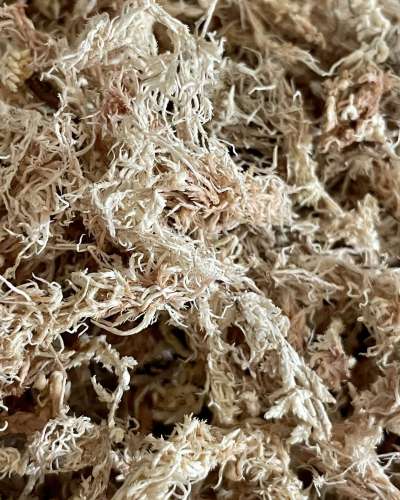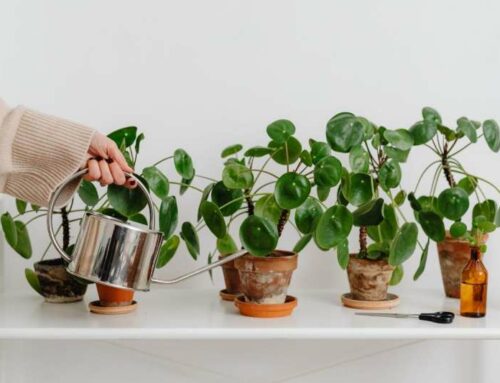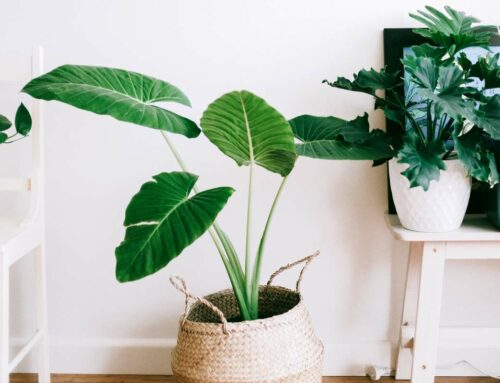Common questions when it comes to plant light: What is bright indirect light? Does a West-facing window provide a houseplant with medium light? How to figure out what is low light?
These and many other plant light related questions might be on your mind if you read that your Monstera needs ‘bright, indirect light’ to thrive or that your Pothos can tolerate a low light spot. No worries, we all have been there! I also used to struggle in the beginning while trying to figure out a location that has at least a medium level of light so that my Dragon Scale Alocasia would tolerate it. So this detailed indoor plant light guide will answer your main plant lighting related questions and will help you decide which location at your home would be the best one to choose for your Monstera Variegata, let’s say.
Different plant species have different light requirements and tolerance levels. Light is the main source of “food” for plants, ensuring their survival. Plants use light to photosynthesize- a process through which plants are able to accumulate energy from light and use it for their growth.
Perhaps, you already know what the light needs of your plant, but what does it mean that a plant would feel best at a location receiving indirect, bright light or at one that offers partial shade? Usually, a lighting source, i.e. natural light coming from a window can be measured with a light-sensitive device, for instance, a lux meter. Without a lux meter, it is hard to figure out if a certain position is the right location for a particular plant, but there are other tell-tale signs whether the light a plant receives is just enough, too much or too little.
In this post, I will explain what the different light requirements of houseplants actually mean and how to use natural light to make your plants thrive!
And hey, don’t worry, understanding the phrases “Bright, Medium and Low” Light for plants is easier once you grasp the basics.
This post may contain affiliate links. Read our Privacy Policy and Disclosure here.
Plant Light Guide for Houseplants: Overview
1. The Different Types of Plant Light for Houseplants
On what does it depend whether a location receives bright or low light?
3 things influence the strenght and the quality of the light: how far away from a window is the spot located; which direction is the window facing, and is there something blocking the natural light coming in directly and landing on the spot (i.e. curtains, maybe an outside fence, etc). Seasonal, weatherly and hourly changes also affect how well lit a spot is.
Choosing a location for a plant where a natural light source will be providing it with adequate light (based on the plant’s requirements) is an essential part of having happy and healthy houseplants around. Thus, it is important to understand the four different types of light for a plant: direct light, bright indirect light, medium light and low light.
What is Direct Light?
Direct light is harsh sunlight that is directly landing at a location without being filteret. When it comes to plant care, direct light is also referred to bright light or full sun.
- Direct sunlight and its radiation are tolerated only by a few plant species. Direct Sun can scorch and cause damage to a plant’s foliage. Most of your houseplants are too fragile to be exposed to direct sunlight and thus, should be protected from it especially during the noon and afternoon hours when the Sun is at its strongest point. You can protect them by either placing them further away from the window or using a light-diffusing curtain in between the plants and the window.
- A few desert cacti species and a few succulents are tolerant of it but even they can become scorched. If your only source of natural light is direct sunlight, you can protect your plants from its damaging rays by using a curtain between the window and the plant. This way, the plants will be receiving filtered rather than direct sunlight which is much more gentle on them.
Window direction: South or South-West
How far from a window: Up to 50cm
Houseplants that would like this light location: desert cacti, i.e. no houseplant really would appreciate this harsh light
What is Bright, Indirect Light?
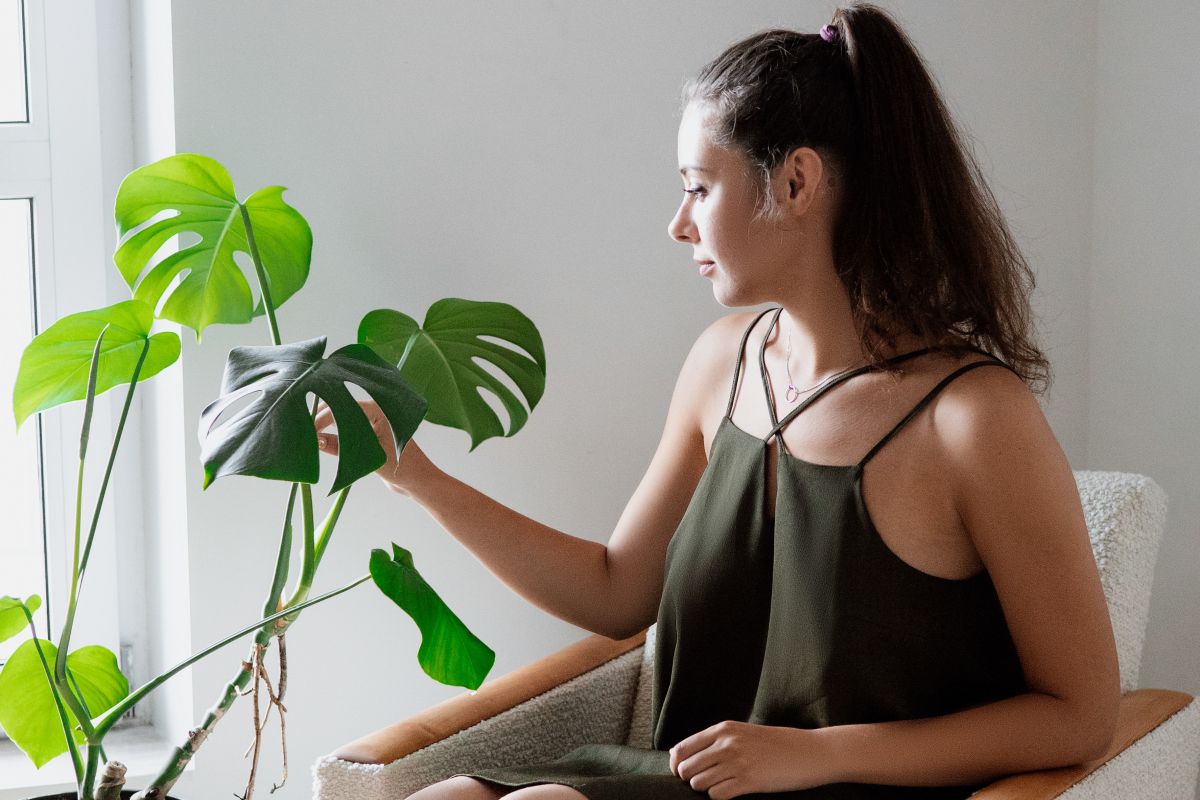
The majority of houseplants would feel their best when they are placed in a location which receives bright, indirect light. So roll up your sleeves and get ready to master this sweet houseplants spot!
- Bright indirect light is essentially the area next to a spot that is receiving bright light. Indirect bright light means that the window’s direction is south but the plant is not placed directly on the window but rather is a meter away. Windows that are large enough and able to provide enough daylight and are east/west oriented, are also suitable.
- Pretty much most of your houseplants need exactly this! Many aroid species; young plants; cuttings.
Window direction: South (filtered), Southeast, Southwest
How far from a window: 50cm to 1m away from a window facing South; up to 50cm from Southeast or Southwest facing windows.
Houseplants that would like this light location: almost all houseplants prefer a location that receives bright, indirect light
How to filter direct light?
As mentioned, if you filter direct sunlight that is coming through a window, you can provide a bright, indirectly lit location for your plants staying on the windowstill. To turn direct sunlight to indirect bright light you would need either a sheer curtain or a window film that has been specially designed to block UV rays and to isolate windows. Depending on their strenght, these filters can block anywhere between 45% to 85% of direct sun rays heat in the high summer.
What is Medium Light?
Medium light for plants is also referred to as partial shade/sunlight. It is a location that most houseplants can tolerate, although their growth might slow down.
- Usually, east or west facing windows provide partial shade/sunlight to plants. Plants placed in such a spot will be enjoying either morning or the gentle evening sun, and will be protected during the harsh sunlight rays at middday.
- A location that receives medium light is ideal for many orchids and flowering houseplant species as they prefer more gentle light and bright, indirect light might be too much for them.
Window direction: East or West
How far from a window: up to 50cm
Houseplants that would like this location: orchids; other houseplants that bloom, peace lily
What is Low Light?
Low light for plants is also called full shade. Typically, plants can be grown in a location receiving natural low light if grow lights are used as a supplement.
- Full shade (low light) – A window that is facing north provides a full shade light, and depending on the number of windows and their sizes in a room, the room can also be low light. Only a few plants will tolerate and grow in a full shade location, as they will be receiving minimal light. The majority of the houseplants that are flowering will not feel well here and if placed in such a location – they will not bloom (eg: peace lilly).
Window direction: North or if the light is blocked by a building close-by (usually, apartments on lower floors)
How far from window: up to 50cm
Plants that can survive here: ZZ plant, epipremnum
Tip: Can’t read a book or chop a carrot without turning on a lamp? Then it’s also too dark for many plants.
The 12 O’Clock Test
The 12 O’clock Test is a simple method to help you determine the light strenght at a spot. If you are still confused about the type of light that a location is receiving and whether it will be a good spot for a plant that you have in mind, here is a simple test to help you figure it out.
At around noon, or at the time when the sunlight is brightest, place an object or go to the spot where you plan to place your plant. Next on, inspect the shadow that that object (or you) is throwing.
- If the shadow is dark, strong and you can clearly see the outline of the object placed, then the light coming in is considered bright light
- If the shadow is light gray but you are still able to see the silhouette, then the light is medium.
- If, however, the shadow is barely visible and it is hard to define its shape, it is a spot receiving low light.
2. The Type of Light a Plant Receives Based on Window Direction
Now that the four different types of light for houseplants have been explained, let’s use some visuals to illustrate them. Continue reading for visual guide on natural light for plants coming from different window directions: south, east, north, west.
South-Facing Window Plant Light Guide
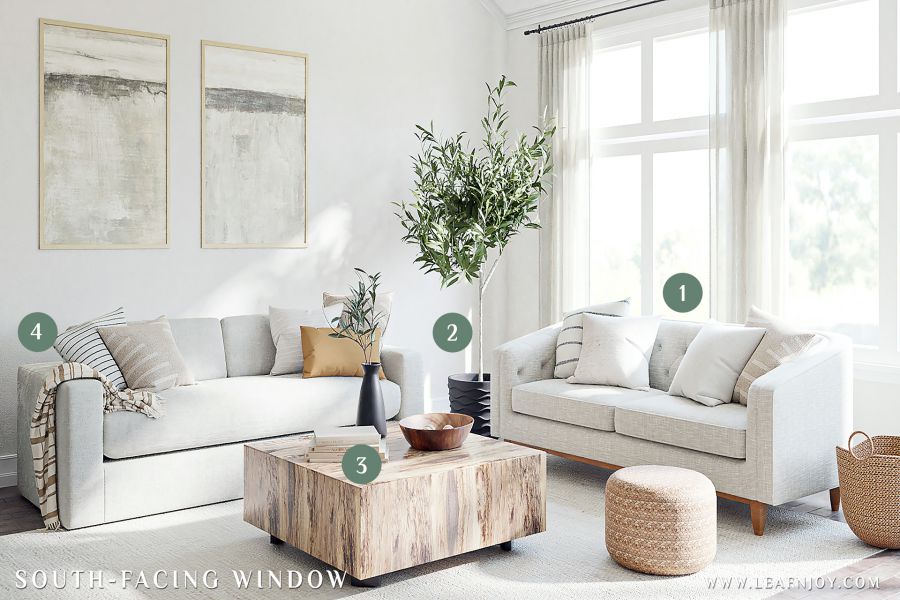
Assume that the window’s direction on the photo above is South. A houseplant will receive different type of light at the different points indicated above. To summarize:
- at point 1: direct sunlight
- at point 2: indirect, bright light
- at point 3: medium light (partial shade)
- at point 4: medium to low light
East Window Plant Light Guide

The photo above is representing the light coming from an east-facing window. A houseplant located at the different points will receive:
- at 1: direct sunlight (but gentle)
- at 2: indirect light
- at 3: medium light
- at 4: medium to low light
West Window Plant Light Guide
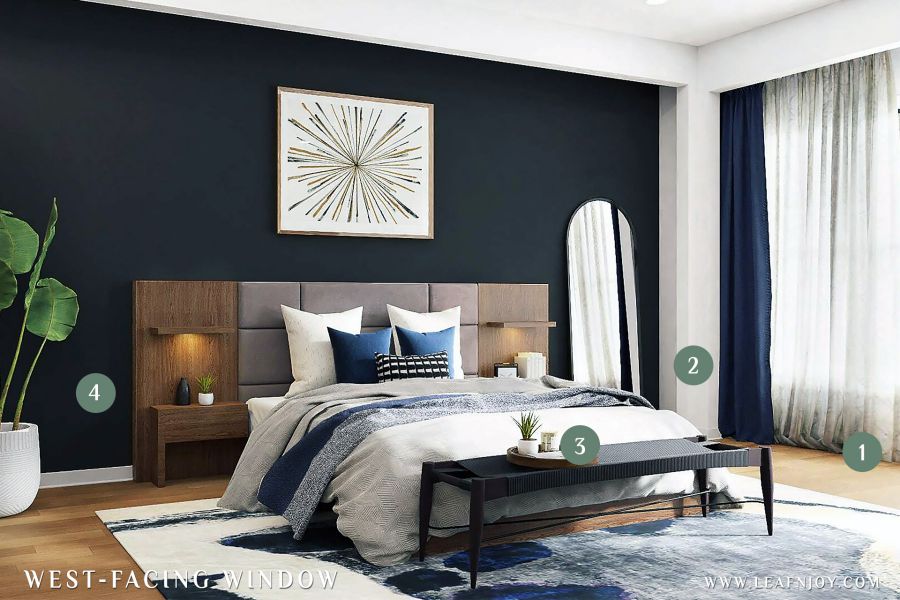
Looking at the type of natural plant light coming from a west-facing window, we have:
- at 1: gentle bright light
- at 2: indirect bright light
- at 3: medium light
- at 4: medium to low light
North Window Plant Light Guide
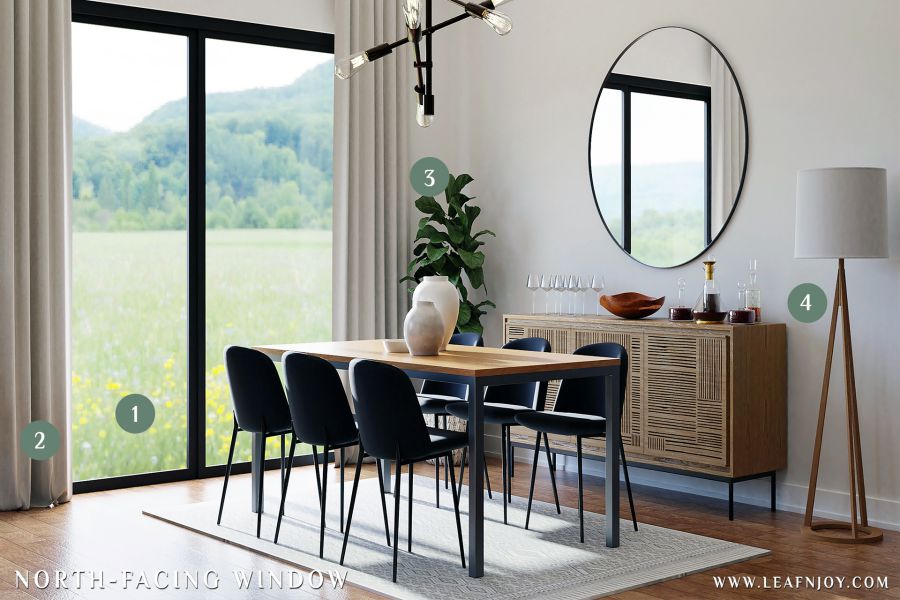
North-facing windows don’t provide plants with bright light. The strenght of natural light stays in the medium ranges.
- at 1: indirect light (bright medium)
- at 2: medium light
- at 3 and 4: low light
3. Houseplants Care: Light Influences Growth
Unless the plant is receiving too mush or too harsh light, a houseplant would usually grow in the direction of the light source. In most cases, this means that it will grow towards a window that is horizontally placed from it. This means that a pot might look more fuller on one side than on the other. This is absolutely normal and expected, to allow the plant to grow equally on all sides, rotate the pot every other week so that all the plant’s foliage is receiving enough light and so that growth will equalize.
Of course, if you have roof windows, the light will be coming from the top and the plant will be prompted to grow in a balanced way. Unfortunately, not many of us have a light source coming from above, so the other technique that you could use is to supplement your plant with a grow light that is providing it with enough light from the top as well. Some succulents would especially benefit from it, as otherwise, they grow way too stretchy and lose their rose-type shape (Echeveria, I’m looking at you!)
Changing a plant’s location:
If you drastically change the location of a plant and thus, it’s light source, expect for the plant to be in a shock for quite some time before it acclimatises to its new place and its new light situation. There are some plant species that are especially sensitive to being moved around, so make sure that if you need to re-arrange your plants that their new locations will be similar in terms of light like their old ones.
How much light do plants need?
The majority of plants will thrive if they receive 12-14 hours of daylight. Rest and dark periods are equally important for plants as it light so make sure that your houseplants have adequate number of dark hours. So in most cases, providing your plant with 20 hours of light daily is not advisable. Eg: preferably away from monitors that might provide them with artificial light during the night
Apart from a plant being placed in a too dark location, problems caused by inadequate light are mostly occurring during the Autumn and Winter months when the natural amount of daylight that plants can enjoy decreases. You can easily help your houseplants during the darker months by supplementing them with a grow light. If you are unsure what a grow light is or how to choose one, make sure to check our detailed guide about choosing and using grow lights for plants here.
Note: Direct sunlight has~32 000- 100 000 LUX, depending on the location and the season.
Signs that a houseplant is receiving too much light
As mentioned above, light is pivotal for the survival and growth of plants. If you have a room where there is no natural light source – then this room is not suitable for a plant. However, too much or too harsh light can sometimes be damaging to plants, so the key is to always try to meet your plant’s requirements.
Signs of too much light:
- Scorching at parts on the foliage that are exposed to the light source
- Flowers shrivel, brown and die-off
- Leaves shrivel, brown and die-off
- Leaves appear droopy
- Burnt leaves and blacken tips
- Leaves fade in colour (usually the leaves that are exposed the most to light)
- Freckles on the leaves (usually the leaves that are exposed the most to light)
- The plant starts growing in the direction opposite of the light source
Scorching happens when a plant is exposed for too long to a light source that is too bright for its preferences. For instance, many houseplants can be scorched by the rays from direct sunlight. Indoor plants prefer in most cases a bright location that is indirectly lit. Scorched (burnt) leaf patches will usually not affect a whole leaf altogether but will be focused on a specific part of it where light is shining on it the most.
Some plants (like Monstera Thai Constellation) also tend to develop the appearance of “freckles” whenever the light source is too much for them.
Signs that a plant is not receiving enough light
On the other hand, there is insufficient light. When a plant is not receiving enough light corresponding to its needs, it will eventually start suffering. Some signs that your plant does not get enough light are:
- yellowing leaves which might die-off
- pale leaves
- growth is slowed down and new leaves emerge looking weak
- The plant grows in a stretchy way as it tries to find a better light source
- the soil does not dry adequately fast for the plant species
- if your have a blooming plant – there are no blooms in sights
- New leaves are smaller
- The plant starts stretching itself towards the light source
Grow Lights for Houseplants
If your plant collection is expanding and you are running out of window space, then you are probably thinking about grow lights for your plants.
No grow light can fully replace natural light and the daily cycles. That is why I personally like to use them as a supplement light whenever necessary rather than as a main light source. If your plant is showing signs that it is not receiving enough hours of natural daylight and if it’s impossible to move it to a location receiving brighter light, consider supplementing it with a grow-light for at least 4 hours on a daily basis and observe if that will be enough.
Grow lights are also great to be used during the autumn and winter seasons when the hours of natural daylight decrease and when plants might suffer from lack of sufficient lighting.
If you are propagating a plant or caring for seedlings that are enclosed in a special location, grow lights might be beneficial as they can be moved around and placed in positions where suitable.
If you opt to invest into a grow light for your houseplants, my recommendation would be to look for a full spectrum grow light, that is: the colour range of the light that the grow light provides is broad and includes all colours. Also ensure that the grow light you plan to invest in, is able to provide adequate light to your houseplants. You can do this by, for example, checking the PPFD or the lux number on the grow light.
Indoor Plant Light Guide: Final Thoughts
Light is one of the most important factors to consider when caring for a plant. Finding a location for a new plant-family member is one of the very first decisions that you would have to make as a plant-parent. Thus, it is important to understand how to determine if the light at a specific location would be fitting for a chosen houseplant.
This detailed guide to houseplant lighting discussed the four different types of light an indoor plant can receive: bright (direct and indirect), medium and low light. As said, the type of light depends strongly (but not only) on the direction of the window. East and west facing windows give off medium light, while a north one – mostly low light. Direct sunlight is too strong for almost all plants, so if you have a south-facing window, make sure to use a something to filter it if plants are placed close to it. Most houseplants prefer bright, indirect light. If you are having doubts about the strenght of natural light at a spot, use the very simple and easy 12 O’Clock Test as a guiding tool.
I hope that this indoor plant light guide has helped you make the best decision about the location of your houseplants so that they can be happy and thriving. :)

